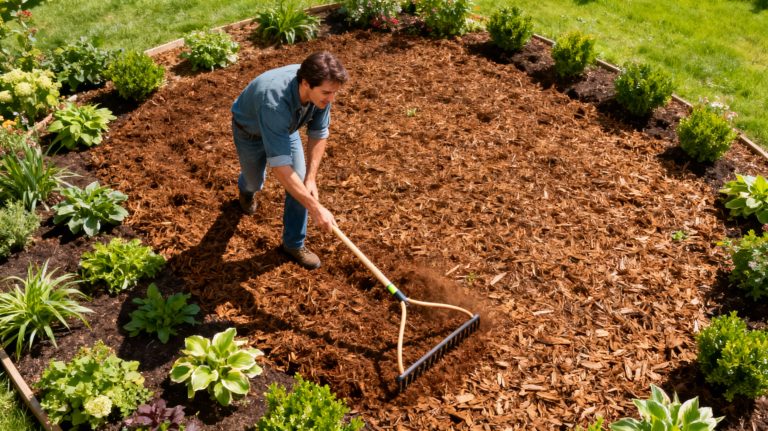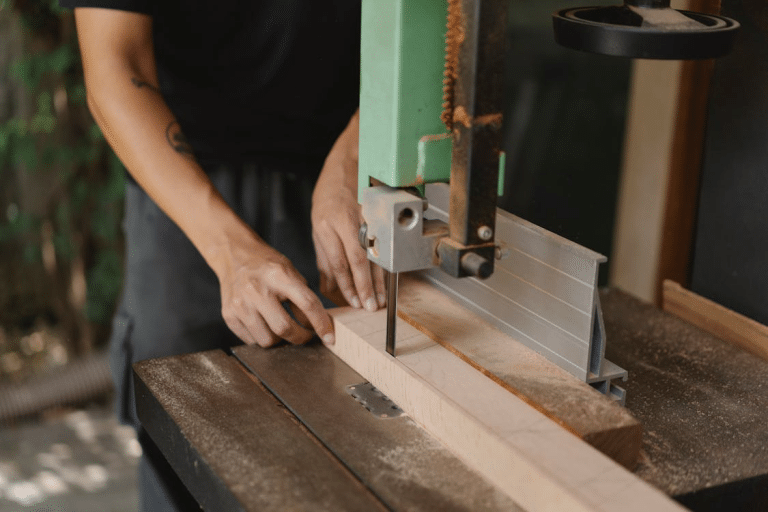I used to dread mulching big beds. The pile in the driveway looked like a mountain, and every trip with the wheelbarrow felt endless.
By the time I got halfway across the yard, the edges were thin, the driveway side was too thick, and my back was already sore. Then I learned a few tricks that completely changed the job.
With some simple staging, the right rake motion, and a quick depth check, you can get an even, finished look in less time than you think. I’ll walk you through the steps that save me hours every season.
Pre-Place Small Piles Every 6–8 Feet for Even Coverage
If you end up with mountains near the driveway and thin spots on the far side of the bed, you’re hauling too far and spreading too little at a time. Fix it by “pre placing” mulch in small piles before you spread anything.
-
Drop kid size piles every 6-8 feet in a loose grid. Keep them 12-18 inches away from plant crowns.
-
Each pile should be enough to cover about 50-75 square feet at 2-3 inches deep. Err on the small side you can always add.
-
Use a wheelbarrow or a tarp you can drag. Tip the load, don’t fling it.
Action → Outcome: After staging two or three piles, you’ll notice you’re raking much more than walking, and the coverage evens out in a few minutes per pile. Within the first half hour, your pace usually doubles because you’re not backtracking.
Smooth Fast with the Back of a Bow Rake
A bow rake (short, stiff tines) is your best friend. Flip it so the flat back is down. Push to knock down the high spots, pull to fill the low ones, and work in short arcs outward from each pile. Think “smooth and spread,” not “drag across the bed.”
-
For loading from the main pile, a mulch fork (with wide, flat tines) is easier on your back than a shovel.
-
Around established plants, finish by hand or with a quick underhand toss. That “soft throw” saves time because you’re not trying to rake around stems.
-
Coarser chips? Make more, smaller piles and use shorter strokes with the rake back they lock together better that way.
Action → outcome: Within a couple of minutes per pile, the surface looks like a calm, even “carpet” with no bald spots or clumps. You shouldn’t be fighting the rake. If you are, your piles are too big or too far apart.
Quick Test for Even Mulch: Check Depth, Ignore Color
Both too thin and too thick mulch cause headaches thin invites weeds, thick sheds water and can suffocate roots. Use your marked stick:
-
Poke straight down in a few random spots per pile. If it’s under 2 inches, steal from a nearby thicker area. If it’s over 4 inches, move some to a thinner zone.
-
Don’t chase color variations. Sun and shade make identical depths look different. Trust the stick.
Good sign: When you check five random points and all fall between 2 and 4 inches, you’re done in that zone no extra smoothing needed.
Work Back to Front, Create an In and Out Loop
Start at the back of the bed and work toward your exit so you’re not walking across finished areas. Stage a simple loop for your wheelbarrow one “in” route and one “out” route so you don’t carve ruts into the lawn or trample plants.
Spread all the interior first, then feather the edges last with the back of the rake so you get a clean, shallow taper at the border. If you’re on a slope, work from the top down and keep piles on the uphill side so you’re not pushing mulch uphill.
Why it Feels Hard: Peaks, Troughs, and Friction
Mulch wants to make hills where it’s dropped and valleys where it isn’t. Our eyes exaggerate those shadows, so “uneven” often means “a few peaks and troughs near the dump points.”
The back of the rake motion matters because it lowers friction you’re nudging material inches, not feet. Short pushes flatten peaks. Short pulls fill troughs. That’s why staging piles close together turns a frustrating drag into a quick smooth.
Mulch Depth and Plant Safety
Aim for 2-4 inches across most ornamental beds. That’s enough to keep moisture in and weeds out without blocking water from reaching the soil.
Keep a donut of bare space about 3 inches around tree trunks and plant stems. No mulch volcanoes around trees. They invite rot and pests.
In perennial clusters, let crowns breathe and keep mulch just shy of the foliage line. In vegetable beds, cover the soil completely but keep mulch lightweight around seedlings so you can pull it back as stems thicken.
You’ll know it’s working when, after the first decent rain or deep watering, the mulch “knits” together and doesn’t float or wash.
If water beads and runs off, you’ve likely gone too thick skim a bit off and redistribute. A week later, you should see fewer new weeds and the soil underneath feel cool and damp to the touch.
Time-Saving Tricks for Big Beds that Cut Steps and Strain
-
Lightly water dry soil before mulching. Damp soil grabs mulch so it stays put, and you won’t kick up dust.
-
Use a tarp as a mobile staging mat. Dump on the tarp, drag it into the bed, flip, and go fewer wheelbarrow lifts.
-
Pair up if you can: one person stages piles, the other spreads. Roles avoid crowding and speed things up.
-
Put the wheelbarrow nose toward the pile and lock the wheel. Shovel from waist height to save your back.
-
Mulch in cooler parts of the day. Heat drains energy. Shade makes you faster.
-
Keep a stiff broom or blower handy to clear stray chips off grass and walks. Mulch left on turf will kill it.
-
For windy sites, choose shredded mulch that interlocks, and stay closer to 2 inches. On slopes, install simple edging or a shallow trench at the bottom to catch strays.
We see most wasted effort coming from hauling too far and fighting clumps, which makes timing your mulch purchase during the cheapest time to buy mulch an even smarter move. Nine times out of ten, tighter pile spacing and using the back of the rake fix both.
Common Questions, Answered Fast for Big Bed Mulching
-
Bags or bulk? For large beds, bulk saves time and money, but knowing the number of mulch bags in a yard helps you plan the right amount without unnecessary trips. If you’re solo with limited lifting, bags can be simpler to stage.
-
How big should each pile be? Think “small hay bale” size you can spread in 3-4 minutes. If you’re tired, make them even smaller.
-
What about throwing mulch? If you’ve got good aim, an underhand toss around plants is efficient. Keep it low and soft to avoid burying crowns.
Summing Up
If you want an easy checkpoint before calling it done, walk the bed and test every 8-10 feet with your depth stick.
If you never drop below 2 inches, don’t see mounds taller than 4 inches, and your edges taper cleanly, you’re finished, even if the shade makes one section look darker.
The goal is the same for DIY or professional help: fewer steps, less strain, and a cleaner result.
If you’d rather have a hand, we can stage piles where they belong, set depth with gauges as we go, and finish edges so you’re not revisiting the bed all week. We usually schedule the same week in season, and a quick walk-through gets you a clear plan either way.













